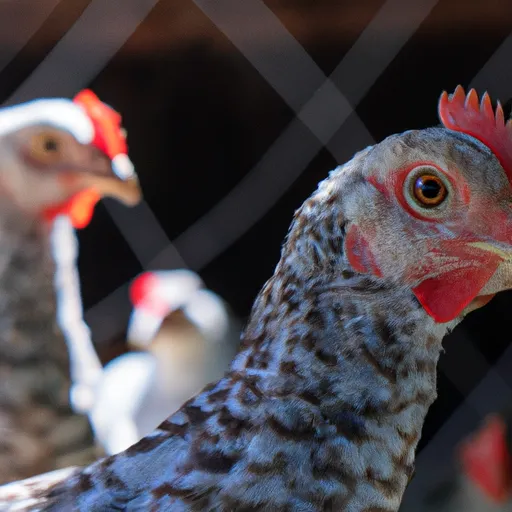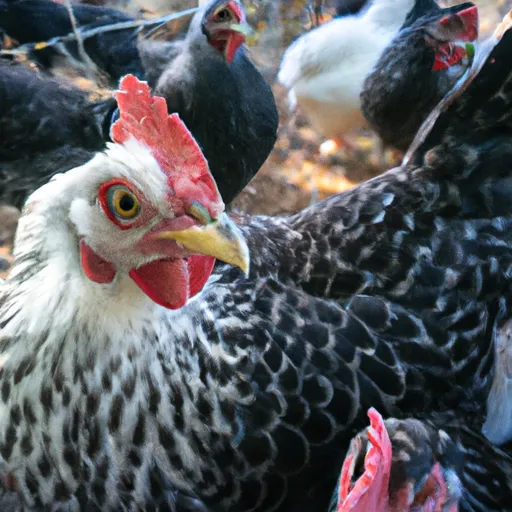A Guide to Barred Rock Chicken
So you're curious about Barred Rock chicken eggs, huh?
Well, look no further, because this guide has all the information you need. From the beautiful coloring that sets Barred Rock eggs apart, to understanding the differences between roosters and hens, we've got you covered.
Whether you're a seasoned chicken enthusiast or just starting your journey with these fascinating birds, this article will provide you with a concise and comprehensive guide to all things Barred Rock eggs.
So sit back, relax, and get ready to learn everything there is to know about these delightful little eggs.
History and Characteristics of Barred Rock Chickens
Origin of Barred Rock Chickens
Barred Rock chickens, also known as Plymouth Rock chickens, have a rich history that dates back to the mid-19th century.
They were first bred in New England, specifically in the state of Massachusetts. The breed was developed by crossing Dominiques, Black Javas, and Black Cochin chickens.
The goal was to create a bird with excellent meat quality and good egg-laying abilities.
Physical Appearance
Barred Rock chickens have a distinctive appearance that sets them apart from other breeds. They have a medium-sized body with a compact build.
The feathers of these chickens are predominantly black with contrasting white or gray bars across their bodies, giving them the "barred" or striped appearance.
The males and females have a similar plumage pattern, making it difficult to visually differentiate between them at first glance.
Both sexes have a single comb and wattles, which stand upright on their heads and necks.
Temperament and Behavior
Barred Rock chickens are known for their friendly and docile nature, making them a favorite among backyard chicken enthusiasts.
They are quite adaptable to different climates and can handle both hot and cold weather conditions. These chickens are generally calm and non-aggressive, which makes them suitable for families with children.
They have a reputation for being good foragers and can thrive in free-range settings.
Barred Rocks also tend to have a strong pecking order within their flock, but they usually get along well with other chicken breeds.

Barred Rock Chicken Eggs
Size and Shape of Barred Rock Chicken Eggs
Barred Rock hens are known for their excellent egg-laying abilities.
They produce medium to large-sized eggs, with an average weight of around 2 to 2.5 ounces (56 to 70 grams). The eggs have an oval shape, typical of most chicken breeds.
Shell Color
The shell color of Barred Rock chicken eggs is brown.
However, it is important to note that the shade of brown can vary slightly between individual hens.
Some eggs may have a lighter tone, while others may have a darker brown hue.
Regardless of the variation, Barred Rock eggs have an attractive and natural brown shell color.
Yolk Color
Barred Rock chicken eggs are known for their rich and vibrant yolk color. The yolks are a deep orange or golden yellow, which is a desirable trait for many egg enthusiasts.
The intensity of the yolk color can be influenced by factors such as the hen's diet and overall health.
Egg Production Rate
Barred Rocks are reliable layers and can produce approximately 200 to 280 eggs per year.
However, it is important to consider that egg production can vary depending on factors such as age, diet, and environmental conditions. With proper care and nutrition, Barred Rock hens can consistently provide a steady supply of fresh eggs.

Hatching and Raising Barred Rock Chicks
Selecting Fertile Barred Rock Eggs
If you're interested in hatching Barred Rock chicks, it is essential to start with fertile eggs.
To ensure success, choose eggs that are free from cracks or deformities and have been properly stored. Fertile eggs will have a prominent "bull's eye" or a dark spot on the yolk, indicating that the egg has been fertilized.
Incubation Process
Once you have selected fertile eggs, you can begin the incubation process. Barred Rock eggs typically require an incubation period of approximately 21 days.
It is important to maintain a consistent temperature and humidity level throughout the incubation period to ensure successful hatching.
Regular monitoring and turning of the eggs are necessary for optimal development.
Brooding Barred Rock Chicks
After the eggs have hatched, it is crucial to provide a suitable brooding environment for the Barred Rock chicks.
This includes a warm and secure space, such as a brooder box or coop, with sufficient bedding, heat sources, and access to food and water.
Barred Rock chicks are relatively hardy and can adapt well to different environments.
However, proper care, including regular feeding, monitoring, and protection from predators, is necessary to ensure their healthy growth and development.
Nutritional Value of Barred Rock Chicken Eggs
Protein Content
Barred Rock chicken eggs are an excellent source of protein.
Each egg contains approximately 6 grams of protein, making them a nutritious addition to any diet. Protein is essential for muscle growth, repair, and overall body function.
Vitamins and Minerals
In addition to protein, Barred Rock eggs contain a variety of essential vitamins and minerals.
They are rich in vitamins A, E, and B12, as well as minerals like calcium and iron.
These nutrients contribute to maintaining healthy eyesight, supporting the immune system, and promoting bone health, among other benefits.
Cholesterol Content
Egg yolks, including those of Barred Rock chickens, contain cholesterol. However, it is important to note that the dietary cholesterol from eggs does not have the same impact on blood cholesterol levels as previously believed.
Moderation is key, and including eggs in a balanced diet can be part of a healthy lifestyle.
Barred Rock Rooster vs Hen
Physical Differences
Physically, male Barred Rock chickens, known as roosters, tend to be larger and more muscular compared to female Barred Rocks, known as hens.
Roosters often have more vibrant feather patterns and larger combs and wattles. Hens, on the other hand, have a slightly smaller size and may have a less pronounced comb and wattles.
Behavioral Differences
Behaviorally, Barred Rock roosters can be more assertive and protective of their flock.
They may exhibit a more dominant nature and engage in behaviors such as crowing, especially in the early morning. Hens, in general, are more docile and focused on their egg-laying duties.
Crowing and Egg Fertilization
One of the key differences between Barred Rock roosters and hens is the ability to crow. Only roosters have the physical capability to produce the loud and distinctive sound associated with crowing.
Also roosters play a vital role in fertilizing the eggs produced by the hens, contributing to the continuation of the flock.
Caring for Barred Rock Chickens
Housing and Space Requirements
Barred Rock chickens can adapt to various housing situations, making them suitable for both small urban backyards and larger rural properties.

Ideally, they should have access to a secure coop or chicken house that provides protection from predators and the elements.
The general rule of thumb is to allow around 4 square feet of coop space per bird and at least 8 to 10 square feet of outdoor roaming area per bird.
Feeding and Watering
A balanced and nutritious diet is crucial for the health and well-being of Barred Rock chickens.
They require a feed that is specifically formulated for laying hens, containing the necessary vitamins, minerals, and protein.
In addition to commercial feed, supplementing their diet with kitchen scraps, vegetable trimmings, and occasional treats such as mealworms can provide added variety and nutritional benefits.
Clean, fresh water should be available at all times.
Healthcare and Disease Prevention
Regular health checks, proper sanitation practices, and disease prevention measures are essential in caring for Barred Rock chickens.
Keep an eye out for any signs of illness or injury, and promptly address any health concerns. It is also crucial to maintain a clean coop, regularly remove droppings, and ensure good ventilation to reduce the risk of respiratory issues.
Vaccinations and regular parasite control should be part of a comprehensive healthcare routine.
Breeding and Genetics of Barred Rock Chickens
Breeding Methods
Breeding Barred Rock chickens can be done through natural mating or artificial insemination. Selecting healthy and genetically diverse breeding stock is essential to maintain the desired characteristics of the breed.
Barred Rocks are relatively easy to breed, and careful selection of parent birds ensures the production of strong and vigorous offspring.
Inheritance of Barred Coloration
Barred coloration in Barred Rock chickens is a result of a dominant gene called "barred" or "B." When a Barred Rock chicken inherits this gene from one of its parents, it will exhibit the characteristic striped pattern.
The barred gene is autosomal, meaning it is not specific to a particular sex chromosome.
Crossbreeding Possibilities
Crossbreeding Barred Rock chickens with other breeds can result in interesting genetic combinations and unique characteristics.
Barred Rocks are commonly crossed with Rhode Island Reds and Buff Orpingtons to create hardy hybrids that possess desirable traits from both parent breeds. These crosses often retain the barred pattern while incorporating other beneficial qualities.
Barred Rock Chickens in the Backyard
Suitability for Backyard chicken Keeping
Barred Rock chickens are highly suitable for backyard chicken keeping.
They are adaptable, docile, and easy to manage, making them an excellent choice for novice chicken keepers.
Their versatility allows them to thrive in both urban and rural settings, provided they have adequate space and proper care.
Permit Requirements
Before getting Barred Rock chickens or any other chicken breed, it is important to check with local authorities regarding any permit requirements or restrictions.

Some areas may have specific regulations on the number of chickens allowed, coop placement, or noise limitations associated with keeping roosters.
Interaction with Other Chicken Breeds
Barred Rock chickens generally have a peaceful demeanor, making them compatible with various chicken breeds. They can coexist harmoniously with other docile breeds, such as Rhode Island Reds, Sussex, or Buff Orpingtons.
It is advisable to introduce new chickens gradually and provide adequate space to establish a pecking order without causing excessive stress.
Uses of Barred Rock Chicken Eggs
Culinary Applications
Barred Rock chicken eggs are versatile and can be used in a wide range of culinary applications.
They can be cooked in various ways, from frying and poaching to baking and boiling.
Their rich flavor and vibrant yolk color make them a popular choice for omelets, frittatas, cakes, and custards.
Decorative and Craft Uses
Barred Rock eggs can also be used decoratively or for craft purposes. Their naturally brown shell color and distinctive appearance lend themselves well to be used as Easter eggs or for creating decorative eggshell art.
The shells can be carefully cleaned and painted or dyed to create beautiful and unique pieces.

Education and Learning Opportunities
Barred Rock chicken eggs provide excellent educational opportunities for children and adults alike.
By incubating and hatching the eggs or observing a hen's natural brooding process, individuals can gain firsthand knowledge of the lifecycle of chickens.
This hands-on experience can foster an understanding of responsibility, agriculture, and nature.
Popular Barred Rock Chicken Varieties
Plymouth Rock
Plymouth Rock chickens, also known as Barred Plymouth Rock, are the most common variety of Barred Rock chickens.
They have the iconic black and white barred plumage and are known for their calm temperament and good egg-laying capabilities. Plymouth Rocks are a reliable and popular choice among backyard chicken enthusiasts.
Rhode Island Red
Crossbreeding Barred Rocks with Rhode Island Reds creates a hybrid known as Black Sex Link.
These chickens inherit the barred pattern from the Barred Rock parent, while the Rhode Island Red parent contributes to their efficient egg production and hardiness.
Black Sex Link hybrids are highly regarded for their friendly nature and excellent egg-laying abilities.
Buff Orpington
Crossing Buff Orpington chickens with Barred Rocks produces a hybrid known as Black Austrolorps. These chickens combine the barred pattern with the appealing buff-colored plumage of the Orpington breed.
Black Austrolorps are known for their docile temperament, good body size, and egg-laying capabilities.
In conclusion, Barred Rock chickens have a fascinating history and possess many desirable characteristics.
From their distinctive appearance and friendly temperament to their nutritious eggs and suitability for backyard chicken keeping, these birds are a popular choice among chicken enthusiasts.
Whether you're interested in raising them for eggs, companionship, or educational purposes, Barred Rock chickens are a delightful addition.
